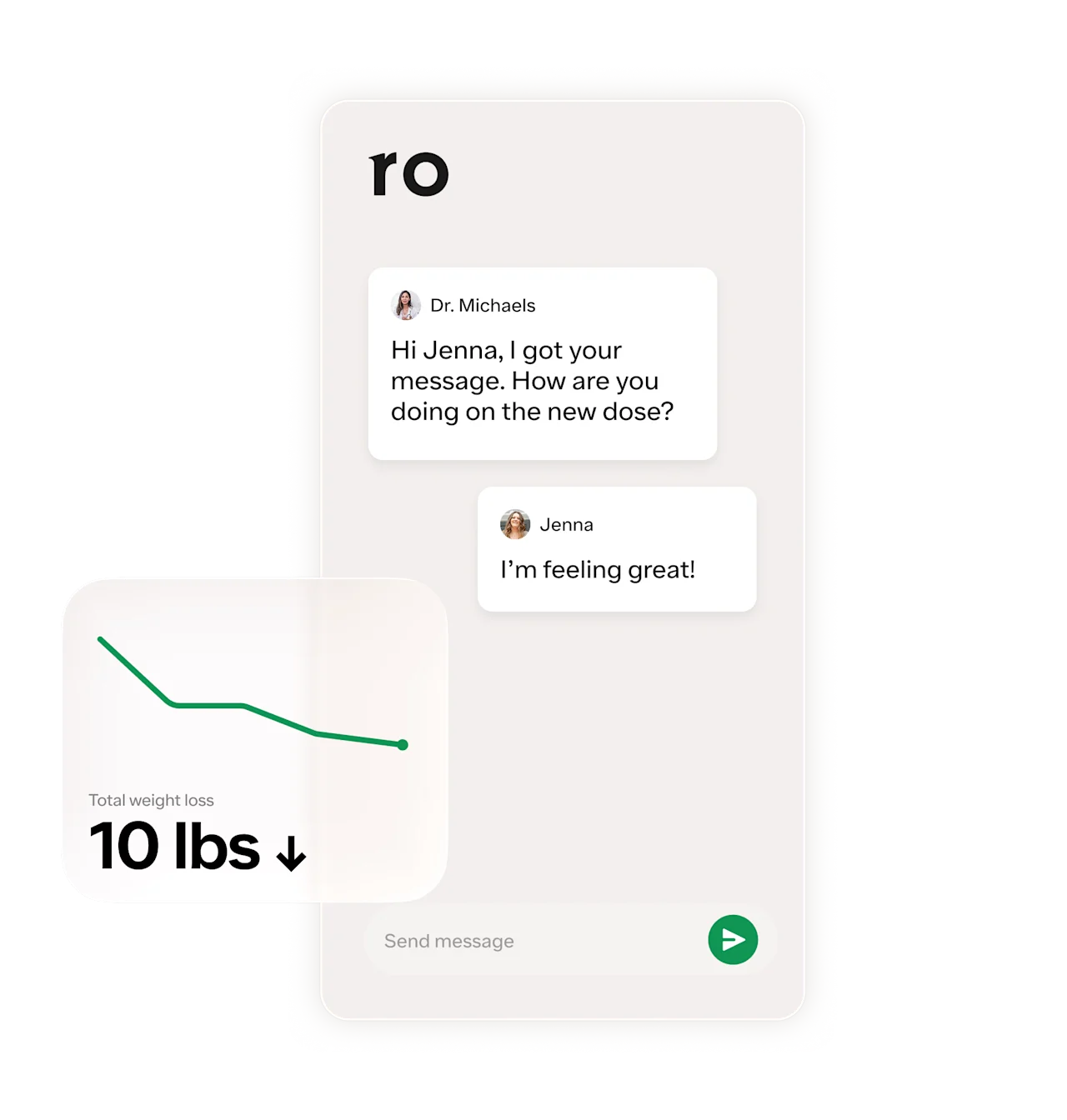Here's what we'll cover
Around one in three older adults has obesity, and one in five has a known diagnosis of diabetes. For these adults, GLP-1 medications like Ozempic that can lower blood sugar and lead to weight loss may be a good option. But, are they riskier to take once you reach age 65? Let’s explore.
What is Ozempic?
Ozempic (semaglutide) is a GLP-1 medication, so-called because it mimics glucagon-like peptide 1, a gut hormone involved in insulin secretion and appetite regulation. The medication, which is only available by prescription, is injected subcutaneously (under the skin) into the upper arm, thigh, or abdomen once a week. Ozempic is supposed to be used in combination with lifestyle changes like diet and exercise to help patients maintain healthy blood sugar levels.
Originally developed to treat type 2 diabetes, Ozempic helps keep blood sugar levels in check by increasing insulin levels and suppressing levels of another hormone, called glucagon, after you eat. This helps stabilize blood sugar and reduce appetite. At the same time, Ozempic slows down digestion by keeping food in your stomach longer. Lastly, GLP-1 sends satiety signals to your brain to tell you you’re full, and may even alter your appetite for certain foods, like those high in calories.
These effects lead to reduced appetite and weight loss, which has led many healthcare providers to prescribe Ozempic off-label to their patients with obesity and overweight. Studies have shown that Ozempic helps 37%-79% of older adults (over age 65) lose at least 5% of their body weight, with those taking higher doses typically losing more weight.
Is it safe to take Ozempic over 65?
If you’re over 65, experts generally agree that Ozempic is safe and effective, as long as you take some extra precautions. In clinical trials, older adults experience similar blood sugar levels and body weight changes to those under age 65. They are also similarly likely to experience side effects when taking Ozempic, which most commonly include:
Nausea
Vomiting
Diarrhea
Abdominal pain
Constipation
However, while most people report mild to moderate side effects on Ozempic, adults age 65 and up are more likely to report more severe side effects. They are also more likely to report other serious side effects, such as hypoglycemia (dangerously low blood sugar), and to discontinue treatment altogether. For example, up to 7% of older adults may stop taking Ozempic due to the side effects, while up to 5.5% of those younger than age 65 do.
For these reasons, older adults may require extra monitoring from their healthcare providers when taking Ozempic. They may also need to take more precautions with nutrition and hydration — to deal with gastrointestinal side effects in the beginning and long-term to mitigate potential health risks, like a loss of muscle mass.
Risks of Ozempic over 65
If you have obesity or overweight, losing 5-10% of your body weight can significantly improve various aspects of your health, from your blood pressure to your walking speed. It can also reduce the risk of death from any cause by 15%. Ozempic can be a safe way to achieve this kind of weight loss, but being older can make taking Ozempic riskier. When prescribing Ozempic to older adults, health providers will weigh the benefits against the risks, and factor in each person’s personal health status as well.
Hypoglycemia
For example, older adults with type 2 diabetes have an increased risk of experiencing hypoglycemia, or low blood sugar. Since Ozempic lowers blood sugar, the risk of hypoglycemia is higher when taking the drug, especially when used in combination with other glucose-lowering medications like insulin.
“If people are taking Ozempic for diabetes, we know the risk of hypoglycemia and its consequences is higher for the elderly,” shared Dr. Beverly Tchang, an endocrinologist who treats patients with obesity, and an advisor to Ro. To reduce this risk, health providers may reduce a patient’s insulin dosage and recommend extra monitoring for older adults taking insulin.
Muscle mass loss
Rapid weight loss, which is common among people being treated with Ozempic, increases the risk of losing lean muscle mass in addition to fat. This loss of muscle mass and strength can make it more difficult to go about your daily activities. It also increases the risk of falls and fractures––especially for older adults.
While different studies show different results in terms of just how much Ozempic decreases lean muscle mass, this is still a concern for older adults. This risk can be mitigated by taking measures to preserve and build muscle mass, such as starting strength training, increasing protein intake, and even speaking to your healthcare provider about reducing your Ozempic dosage to slow the rate of weight loss.
Osteoporosis
Another concern is osteoporosis, which is weakened bones. While obesity can increase fracture risk for adults ages 65 and older, so can weight loss. Specifically, weight loss can decrease bone mineral density in the hips.
However, research also shows that exercise, and in particular strength training, can counteract these effects. Ensuring you get enough calcium and vitamin D (which helps boost your body’s absorption of calcium), through both diet and supplements, may be recommended as well.
Who is Ozempic right for?
Ozempic may be recommended to people with type 2 diabetes who need help controlling their blood sugar levels. It may also be prescribed to people with type 2 diabetes and established heart disease to lower their cardiovascular risk. When prescribed off-label, Ozempic can help people with obesity or overweight who have struggled to lose a significant amount of weight through diet and exercise alone.
“Ozempic is indicated for people with uncontrolled type 2 diabetes who may also have cardiovascular disease or obesity. If using Ozempic off-label for obesity, we typically reserve it for those who have a body mass index (BMI) of 30 or greater, or people who have a BMI of 27 or greater plus a weight-related comorbidity,” shared Dr. Tchang.
“However, these are guidelines, and the choice to start Ozempic also depends on your age, medical history, and any other medical conditions you might have,” Dr. Tchang continued. “Postmenopausal women with osteoporosis, for example, may actually see decreases in their bone mineral density when they lose weight, so they should be counseled on the risks and benefits of weight loss.”
The World Health Organization lists a BMI between 18.5-24.9 kg/m as “normal,” with 25–29.9 being overweight and 30 and above being obese. However, one study suggests that older adults in this normal BMI range are actually more likely to have decreased muscle strength, malnutrition, a higher fall risk, and problems with their gait and balance. Instead, the researchers recommended that a healthy “normal” BMI range for older adults should be much higher — 31–32 for women and 27–28 for men to account for the age-related changes in body composition and bone and muscle mass.
Dr. Tchang also cautions against relying on the standard BMI guidelines when prescribing Ozempic to older adults. “If they are taking Ozempic off-label for obesity, older adults should have an informed discussion with their doctor about what the weight goal should be. Large population studies have shown that being in the overweight BMI range for older people may actually be ideal because lower weights mean even lower muscle mass, and low muscle mass increases the risk of falls, broken bones, etc.”
Ozempic is not safe for everyone. Adults 65 and up with a personal or family history of thyroid cancer, pancreatitis, or an allergy to semaglutide (the active ingredient in Ozempic) should not take Ozempic. Additionally, people who take insulin or who have a history of diabetic retinopathy, or kidney or gallbladder problems may require extra monitoring when using Ozempic.
How to avoid muscle loss
It is natural to lose muscle mass as you age. When we’re young, lean muscle mass may represent 50% of our total body weight. By the time we reach 75 or 80, that drops to 25%. Stronger muscles and stronger bones go hand in hand. That’s because the tension on our bones from strong and healthy muscles promotes bone mineralization and strength. That’s why muscle mass loss can contribute to reduce bone mineral density, resulting in an increased risk of falls and fractures.
Here are three ways to avoid muscle loss when taking Ozempic.
Add strength training to your workouts
Resistance training can prevent the loss of muscle mass that can occur with weight loss. Strengthening your muscles improves your balance and physical functioning, while reducing your risk of falls or fractures. Resistance training also helps offset the loss of bone mass density that can occur with weight loss. To prevent muscle mass loss, experts recommend doing strength training twice weekly.
“They should be prioritizing physical activity, especially strength training, to preserve muscle mass; and weight-bearing exercises to preserve bone strength,” shared Dr. Tchang. “While activities like cycling and swimming are great for cardiovascular health, older adults should also be engaging in exercises that focus on resistance training, weight-lifting, etc.”
Increase your daily protein intake
As you get older, your body’s ability to generate and repair muscle using dietary protein can drop off. As a result, older adults may need even more protein to help build and maintain muscle.
Following a higher-protein diet has been shown to preserve lean muscle mass while boosting fat loss in older adults. Experts recommend that older adults eat at least 0.5 grams of protein for each pound of body weight daily, or around 25–30 grams per meal. You can find protein in foods like meat, eggs, soy, grain, nuts, seeds, and legumes.
Increase your daily calcium intake
Both the aging process and diet-induced weight loss reduce the body’s ability to absorb calcium, so older adults taking Ozempic need to be particularly careful about ensuring they get enough calcium. Increasing your intake of both calcium and vitamin D can improve bone density in older adults. Meeting the daily recommended calcium intake can also help slow the rate of bone loss. Experts recommend 1,200 mg of calcium for women over 50 and men over 70, and 1,000 mg for men ages 51 to 70.
Depending on your personal health situation, your healthcare provider may recommend taking calcium supplements, although getting enough calcium from a well-balanced diet is often an easier option. You can find calcium in dairy products like milk, yogurt, cheese, leafy green vegetables like broccoli and kale. Some foods are also fortified with calcium, including some cereals, grains, and fruit juices.
Medicare Coverage for Ozempic
In terms of whether Medicare covers Ozempic, the answer is: it depends. Medicare Part D typically does not provide prescription drug coverage for weight loss drugs, so if you are taking Ozempic exclusively for weight management and you don’t have type 2 diabetes, it may not be covered. However, if your healthcare provider prescribes Ozempic to treat type 2 diabetes, it can be.
The same goes for other GLP-1 medications like Mounjaro. If they are FDA-approved for type 2 diabetes and have been prescribed for type 2 diabetes, they are more likely to be covered. GLP-1 medications that are FDA-approved specifically for weight loss, like Saxenda and Wegovy, are currently not covered by Medicare, though the landscape is changing constantly..
Without assistance from Medicare, how much you pay for Ozempic will depend on any other insurance coverage you might have. Some plans only provide coverage for patients with type 2 diabetes, and others may require a prior authorization from your healthcare provider before they cover the drug. Review your drug formulary and contact your insurance provider to be sure.
To reduce the cost of Ozempic, explore other ways to save. You may be able to save by price-checking local pharmacies. Sometimes, ordering a longer, two- or three-month supply can be more cost-effective than purchasing one-month refills. Or, if you have commercial or private insurance, you may be eligible for the Savings Offer from Novo Nordisk, the makers of Ozempic, which can bring the cost to as low as $25 for a 30-day supply.
If you are 65 or older, talk to a health provider about your weight-loss options. They can help you determine whether Ozempic may be a good fit for you.
DISCLAIMER
If you have any medical questions or concerns, please talk to your healthcare provider. The articles on Health Guide are underpinned by peer-reviewed research and information drawn from medical societies and governmental agencies. However, they are not a substitute for professional medical advice, diagnosis, or treatment.
References
Ardeljan, A. D. & Hurezeanu, R. (2022). Sarcopenia. StatPearls. Retrieved Aug. 8, 2023 from https://www.ncbi.nlm.nih.gov/books/NBK560813/
Batsis, J. A. & Zagaria, A. B. (2018). Addressing Obesity in Aging Patients. The Medical Clinics of North America, 102(1), 65–85. doi:10.1016/j.mcna.2017.08.007. Retrieved from https://www.ncbi.nlm.nih.gov/pmc/articles/PMC5724972/
Ida, S., Kaneko, R., Imataka, K., et al. (2021). Effects of Antidiabetic Drugs on Muscle Mass in Type 2 Diabetes Mellitus. Current Diabetes Reviews, 17(3), 293–303. doi:10.2174/1573399816666200705210006. Retrieved from https://pubmed.ncbi.nlm.nih.gov/32628589/
Jiang, B. C. & Villareal, D. T. (2019). Weight Loss-Induced Reduction of Bone Mineral Density in Older Adults with Obesity. Journal of Nutrition in Gerontology and Geriatrics, 38(1), 100–114. doi:10.1080/21551197.2018.1564721. Retrieved from https://www.ncbi.nlm.nih.gov/pmc/articles/PMC6480356/
Kıskaç, M., Soysal, P., Smith, L., et al. (2022). What is the Optimal Body Mass Index Range for Older Adults?. Annals of Geriatric Medicine and Research, 26(1), 49–57. doi:10.4235/agmr.22.0012. Retrieved from https://www.ncbi.nlm.nih.gov/pmc/articles/PMC8984168/
Kritchevsky, S. B., Beavers, K. M., Miller, M. E., et al. (2015). Intentional weight loss and all-cause mortality: a meta-analysis of randomized clinical trials. PloS One, 10(3), e0121993. doi:10.1371/journal.pone.0121993. Retrieved from https://www.ncbi.nlm.nih.gov/pmc/articles/PMC4368053/
Novo Nordisk. (2022). Save on Ozempic® | Ozempic® (semaglutide) injection 0.5 mg or 1 mg. Retrieved Aug. 8, 2023 from https://www.ozempic.com/savings-and-resources/save-on-ozempic.html
Nowson, C. & O'Connell, S. (2015). Protein Requirements and Recommendations for Older People: A Review. Nutrients, 7(8), 6874–6899. doi:10.3390/nu7085311. Retrieved from https://www.ncbi.nlm.nih.gov/pmc/articles/PMC4555150/
Plantz, M. A. & Bittar, K. (2022). Dietary Calcium. StatPearls. Retrieved Aug. 8, 2023 from https://www.ncbi.nlm.nih.gov/books/NBK549792/
Ryan, D. H. & Yockey, S. R. (2017). Weight Loss and Improvement in Comorbidity: Differences at 5%, 10%, 15%, and Over. Current Obesity Reports, 6(2), 187–194. doi:10.1007/s13679-017-0262-y. Retrieved from https://www.ncbi.nlm.nih.gov/pmc/articles/PMC5497590/
U.S. Food and Drug Administration (FDA). (2022). Highlights of Prescribing Information: Ozempic (semaglutide) injection, for subcutaneous use. Retrieved from https://www.accessdata.fda.gov/drugsatfda_docs/label/2022/209637Orig1s009lbl.pdf
Volpe, S., Lisco, G., Racaniello, D., et al. (2022). Once-Weekly Semaglutide Induces an Early Improvement in Body Composition in Patients with Type 2 Diabetes: A 26-Week Prospective Real-Life Study. Nutrients, 14(12), 2414. doi:10.3390/nu14122414. Retrieved from https://www.ncbi.nlm.nih.gov/pmc/articles/PMC9227575/
Warren, M., Chaykin, L., Trachtenbarg, D., et al. (2018). Semaglutide as a therapeutic option for elderly patients with type 2 diabetes: Pooled analysis of the SUSTAIN 1-5 trials. Diabetes, Obesity & Metabolism, 20(9), 2291–2297. doi:10.1111/dom.13331. Retrieved from https://www.ncbi.nlm.nih.gov/pmc/articles/PMC6099273/












